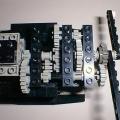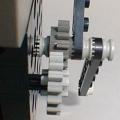Clock
The Clock uses the Lego MindStorms Robotics Invention System to keep accurate time on a conventional analog clock face.

More photos of the Clock:
 |
 |
 |
 |
The clock uses a fiber-optic component as a rotation sensor, to step the motor by a fixed increment of 1/16 of a turn. This is geared down by a factor of three to drive the minute hand, and by a further factor of twelve to drive the hour hand. The hands are mounted coaxially, with the hour hand driven directly by the main axle. The minute hand is attached to a gear which is free to spin independently of the main axle, driven by a neighbouring gear on a seperate axle.
The simple gearing combined with the resolution of the rotation sensor results in the minute hand requiring 3 x 16 = 48 steps per hour to keep correct time. This is accomplished by stepping on four minutes out of every five. A simple NQC program monitors the RCX's internal clock and steps the motor on minutes that are not multiples of five. Each step toggles the state of the light/rotation sensor.
The accuracy of the clock is derived from that of the RCX's oscillator. My RCX seems to gain about a second each hour, or roughly twelve minutes each month. Compensating for this drift in software is left as an exercise for the reader. :-)
Building instructions
Building instructions for the clock are available here as a series of 35 images in five parts.The Clock files:
Copyright © 1999 Ben Williamson
